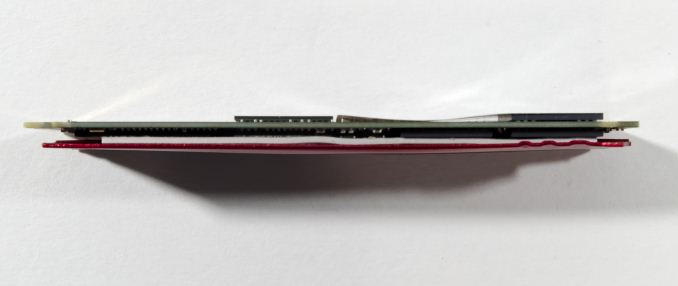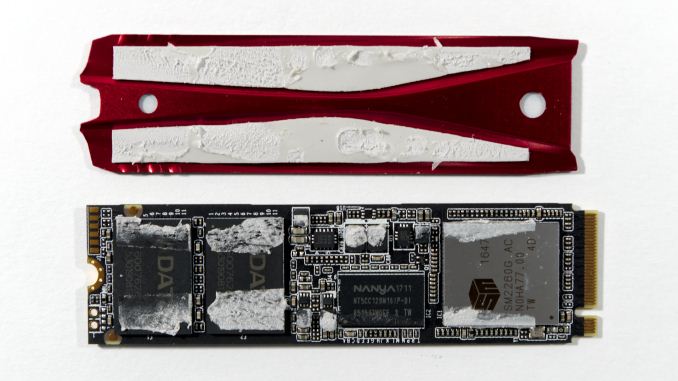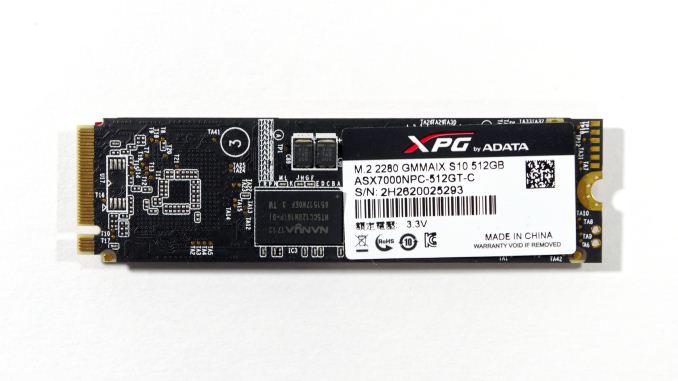
Original Link: https://www.anandtech.com/show/11934/the-adata-xpg-gammix-s10-512gb-ssd-review
The ADATA XPG GAMMIX S10 (512GB) SSD Review: Entry-Level NVMe With Style
by Billy Tallis on October 25, 2017 8:30 AM EST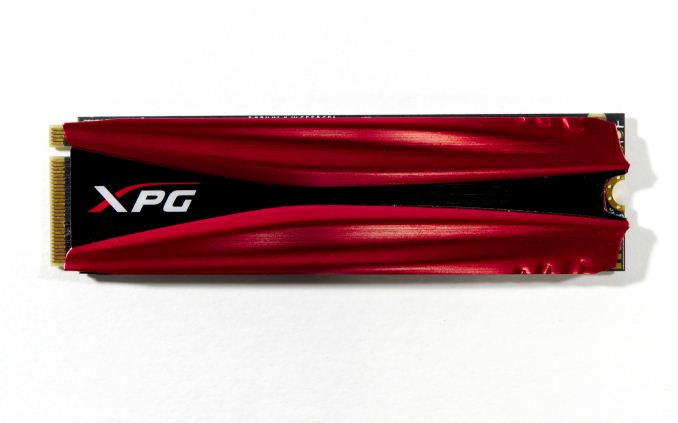
The ADATA XPG GAMMIX S10 is a M.2 NVMe SSD with very enthusiast-oriented branding and packaging, but it isn't even close to being ADATA's top NVMe SSD. Instead, it's a derivative of their entry-level XPG SX7000 M.2 NVMe SSD, adding only a heatspreader. Underneath, the SX7000 and the GAMMIX S10 both use Micron 32-layer 3D TLC NAND with the Silicon Motion SM2260 controller. This combination is also used in the Intel SSD 600p, which has been one of the cheapest NVMe SSDs on the market.
The Silicon Motion SM2260 controller is their first NVMe SSD controller. SMI's initial aspirations for the controller were high, but it has instead found its niche as the cheap but slower option. The SM2260 was the first NVMe controller to offer a turnkey firmware solution for use with Intel/Micron 3D NAND. That allowed Silicon Motion to win back some market share from from Phison, whose controllers including the PS5007-E7 NVMe controller are largely tied to Toshiba NAND. This is an important distinction as Toshiba's 3D NAND has yet to make an appearance in any third-party SSDs. For SSD vendors that source both NAND and controllers on the open market, Silicon Motion and Micron have been the only 3D NAND option for the past year.
The Intel/Micron 32-layer 3D NAND flash memory was the second 3D NAND to ship in volume (after Samsung's V-NAND), and the first to be widely available on the open market, as Samsung uses most of their flash for their own SSDs. Micron's 3D NAND has proven to be slower than Samsung's, but reasonably power efficient when paired with the right controller. It is also fairly cost-effective, and SSDs with Intel/Micron 3D NAND have been dominating the value SSD market for more than a year.
A new generation of Silicon Motion NVMe controllers has been announced but is still months away from being ready to hit the shelves. The 64-layer Intel/Micron 3D NAND has seen a very limited release in the Intel 545s, but the flash used by the ADATA XPG GAMMIX S10 can't be replaced yet. Meanwhile, ADATA is now able to buy Micron's 32-layer 3D NAND by the wafer and do their own binning and packaging. As their top TLC SSD, the GAMMIX S10 is likely equipped with the highest grade of 3D NAND that goes into ADATA's consumer drives.
| ADATA XPG GAMMIX S10 Specifications | ||||
| Capacity | 128 GB | 256 GB | 512 GB | 1 TB |
| Model Number | ASX7000NPC- 128GT-C |
ASX7000NPC- 256GT-C |
ASX7000NPC- 512GT-C |
ASX7000NPC- 1TT-C |
| Controller | Silicon Motion SM2260 | |||
| NAND Flash | Micron 384Gb 32L 3D TLC NAND | |||
| Form-Factor, Interface | M.2-2280, PCIe 3.0 x4, NVMe 1.2 | |||
| Sequential Read | 660 MB/s | 1370 MB/s | 1750 MB/s | |
| Sequential Write | 450 MB/s | 820 MB/s | 860 MB/s | 850 MB/s |
| Random Read IOPS | 35K IOPS | 70K IOPS | 130K IOPS | |
| Random Write IOPS | 95K IOPS | 130K IOPS | 140K IOPS | |
| Warranty | 5 years | |||
| MTBF | 2,000,000 hours | |||
The specifications for the ADATA XPG GAMMIX S10 are typical for an entry-level NVMe SSD. The 128GB model has severely reduced performance potential due to not being able to populate every channel of the controller with NAND flash chips, while the 512GB and 1TB models offer about the same performance. Despite having a PCIe 3.0 x4 link that is capable of almost 4GB/s, the GAMMIX S10 won't even hit 2GB/s. ADATA doesn't officially list write endurance, but the five-year warranty is a step up from what most entry-level SSDs offer, even in the NVMe market segment.
The heatspreader on the ADATA XPG GAMMIX S10 keeps to a fairly low profile, but isn't just a single sheet of metal. The main body of the heatspreader is red, and there's a recessed section down the middle that holds a black insert. On the underside of the heatspreader, this leads to thermal compound only being used on the outer edges of the heatspreader, and it makes very little contact with the controller itself. This heatspreader isn't purely cosmetic, but it will cool the drive much less than a first glance suggests it should.
The GAMMIX S10 is a double-sided M.2 card, with some DRAM, NAND flash, and smaller components on the back. Smaller capacities than our 512GB sample may omit the DRAM package on the back.
This review will compare the 512GB ADATA XPG GAMMIX S10 against a variety of NVMe and SATA SSDs. The closest competitors are mostly other NVMe SSDs using TLC NAND, so those drives have been highlighted in the bar charts.
| AnandTech 2017 SSD Testbed | |
| CPU | Intel Xeon E3 1240 v5 |
| Motherboard | ASRock Fatal1ty E3V5 Performance Gaming/OC |
| Chipset | Intel C232 |
| Memory | 4x 8GB G.SKILL Ripjaws DDR4-2400 CL15 |
| Graphics | AMD Radeon HD 5450, 1920x1200@60Hz |
| Software | Windows 10 x64, version 1703 |
| Linux kernel version 4.12, fio version 2.21 | |
- Thanks to Intel for the Xeon E3 1240 v5 CPU
- Thanks to ASRock for the E3V5 Performance Gaming/OC
- Thanks to G.SKILL for the Ripjaws DDR4-2400 RAM
- Thanks to Corsair for the RM750 power supply, Carbide 200R case, and Hydro H60 CPU cooler
AnandTech Storage Bench - The Destroyer
The Destroyer is an extremely long test replicating the access patterns of very IO-intensive desktop usage. A detailed breakdown can be found in this article. Like real-world usage, the drives do get the occasional break that allows for some background garbage collection and flushing caches, but those idle times are limited to 25ms so that it doesn't take all week to run the test. These AnandTech Storage Bench (ATSB) tests do not involve running the actual applications that generated the workloads, so the scores are relatively insensitive to changes in CPU performance and RAM from our new testbed, but the jump to a newer version of Windows and the newer storage drivers can have an impact.
We quantify performance on this test by reporting the drive's average data throughput, the average latency of the I/O operations, and the total energy used by the drive over the course of the test.
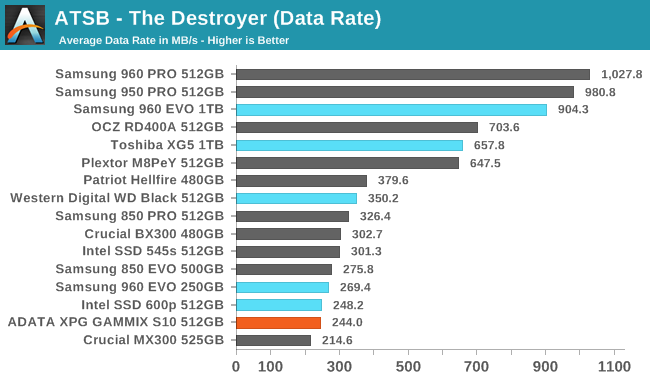
The ADATA XPG GAMMIX S10 delivers an average data rate on The Destroyer that is essentially tied with the Intel 600p. This performance falls within the range of mainstream SATA SSDs, while most other TLC-based NVMe SSDs can at least outperform SATA SSDs.
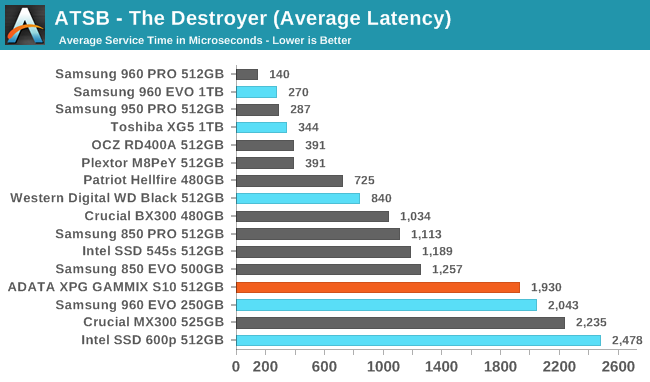
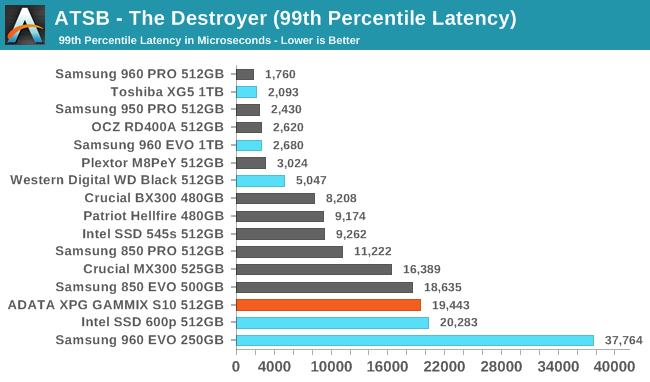
The average latency of the GAMMIX S10 on The Destroyer is substantially better than the Intel 600p, while its 99th percentile latency is only slightly improved over the 600p. On both metrics, the GAMMIX S10 still rates worse than many mainstream SATA SSDs.
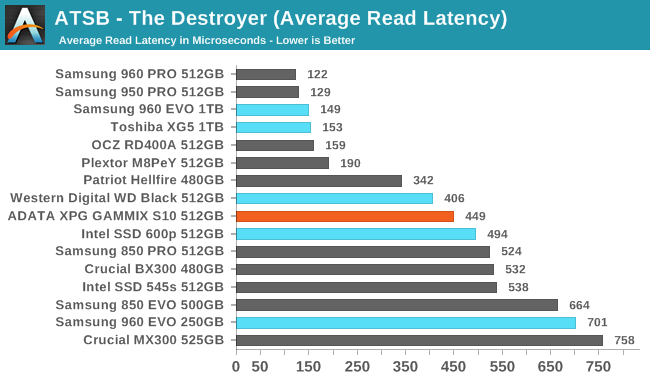
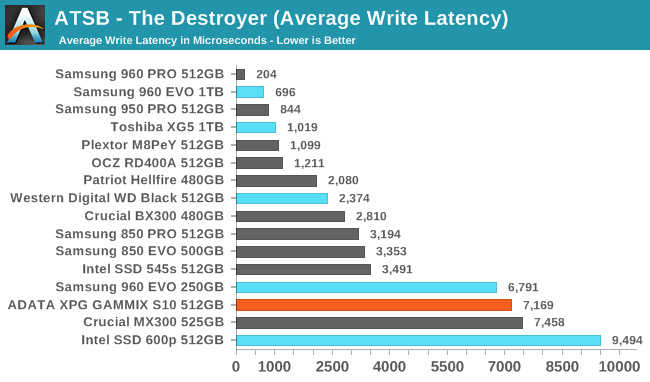
The average read latency of the GAMMIX S10 on The Destroyer is better than any SATA SSD and better than the Intel 600p. The average write latency is a significant improvement over the 600p but is otherwise still quite bad, with latency twice as high as typical mainstream SATA SSDs.
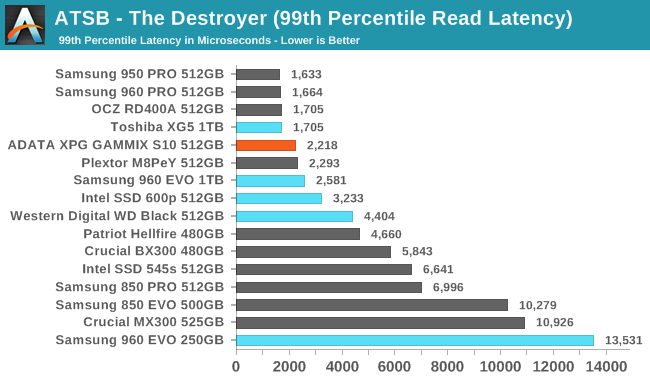
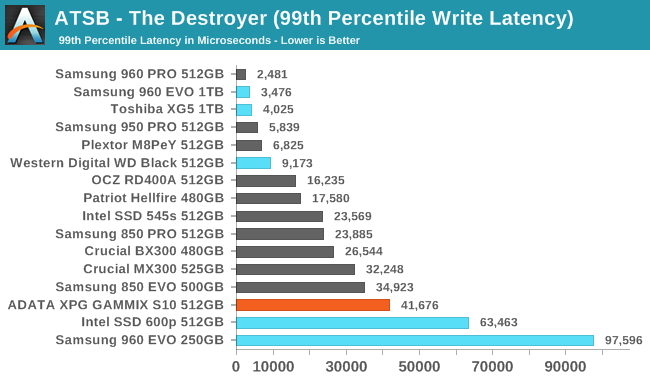
The 99th percentile read latency of the GAMMIX S10 is great, but not quite fast enough to place it in the very top tier of drives along Samsung and Toshiba. The 99th percentile write latency ranks at the other end of the field, worse than most mainstream SATA SSDs, though trailing by a less embarrassing margin than the Intel 600p.
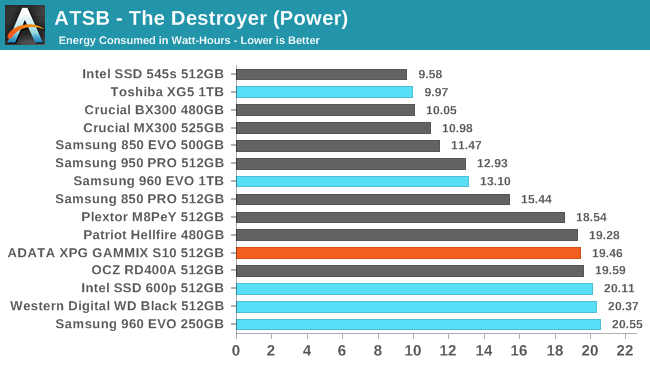
The energy usage of the ADATA XPG GAMMIX S10 on The Destroyer is typical for NVMe SSDs. It's a bit more efficient than the Intel 600p or WD Black, but still uses twice as much energy as a good SATA SSD.
AnandTech Storage Bench - Heavy
Our Heavy storage benchmark is proportionally more write-heavy than The Destroyer, but much shorter overall. The total writes in the Heavy test aren't enough to fill the drive, so performance never drops down to steady state. This test is far more representative of a power user's day to day usage, and is heavily influenced by the drive's peak performance. The Heavy workload test details can be found here. This test is run twice, once on a freshly erased drive and once after filling the drive with sequential writes.
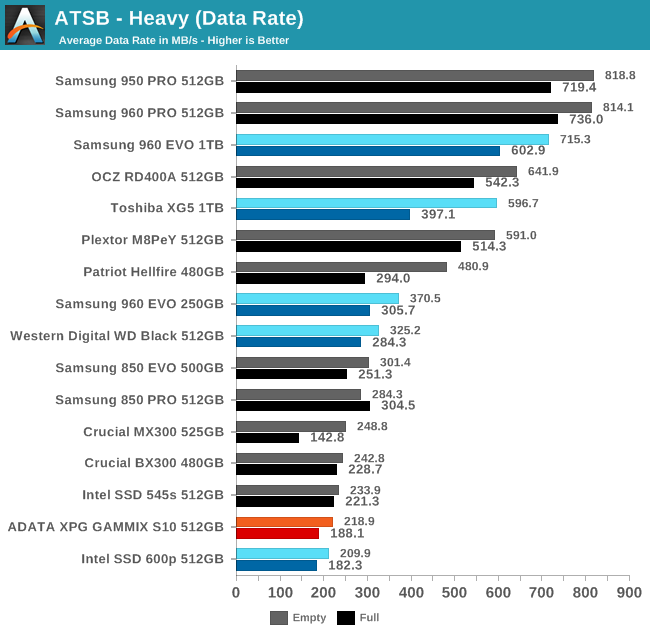
The ADATA XPG GAMMIX S10 doesn't handle the Heavy test much better than the Intel 600p did. Both deliver a lower average data rate than many SATA SSDs.
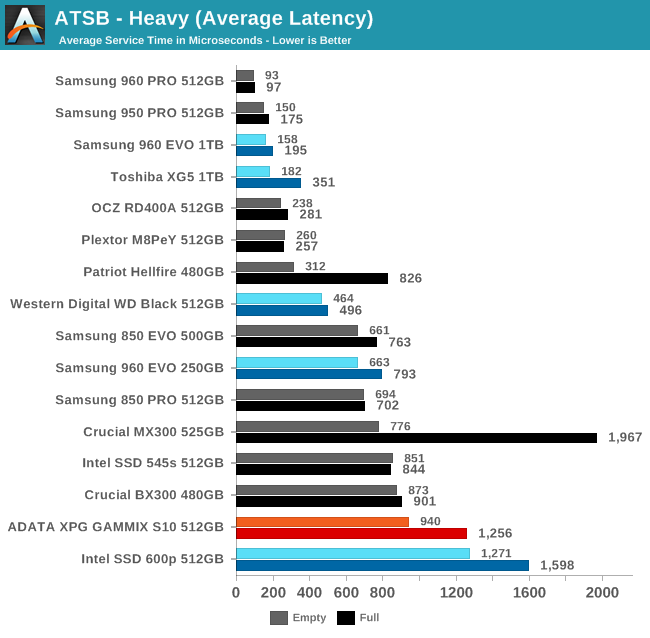
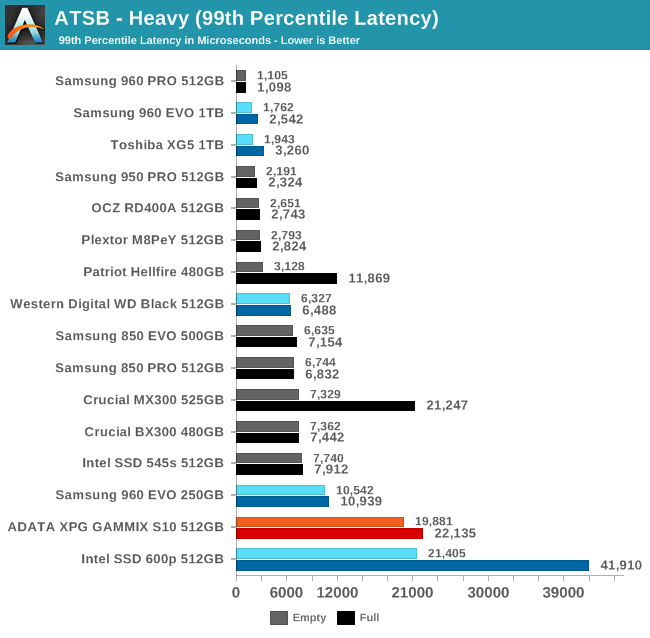
Both the average and 99th percentile latency scores of the GAMMIX S10 on the Heavy test are a clear improvement over the Intel 600p, but both drives are behind mainstream SATA drives and even further behind the TLC NVMe competition.
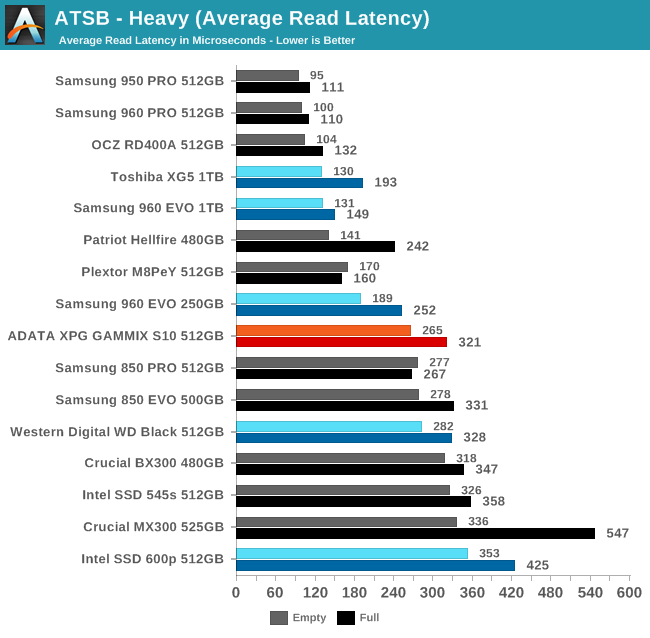
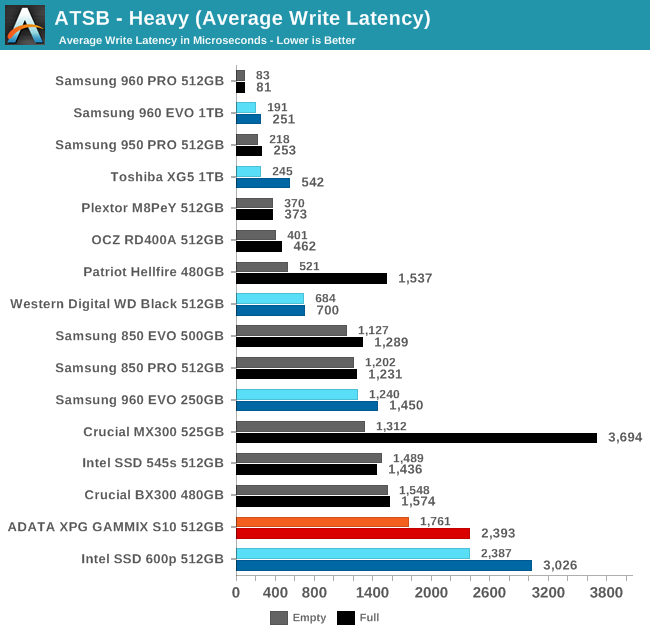
The average read latency of the GAMMIX S10 is slightly better than most SATA SSDs, but substantially higher than the typical NVMe SSD. The average write latency is more of a problem, as it is generally higher than mainstream SATA SSDs.
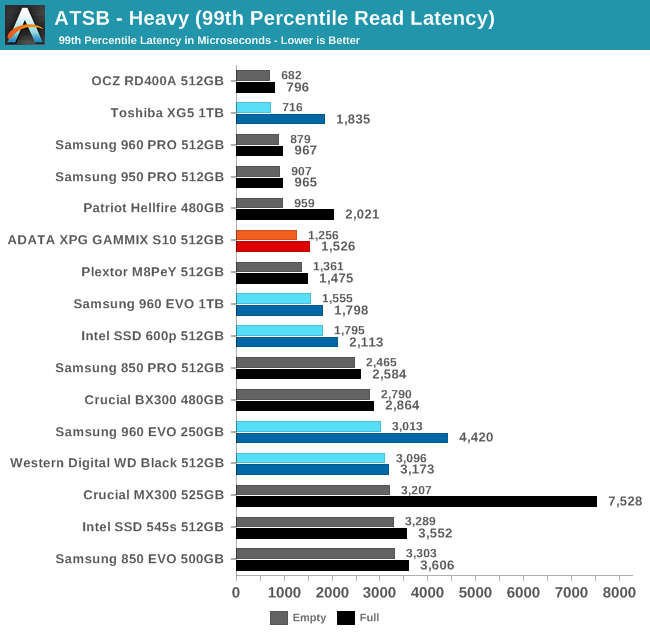
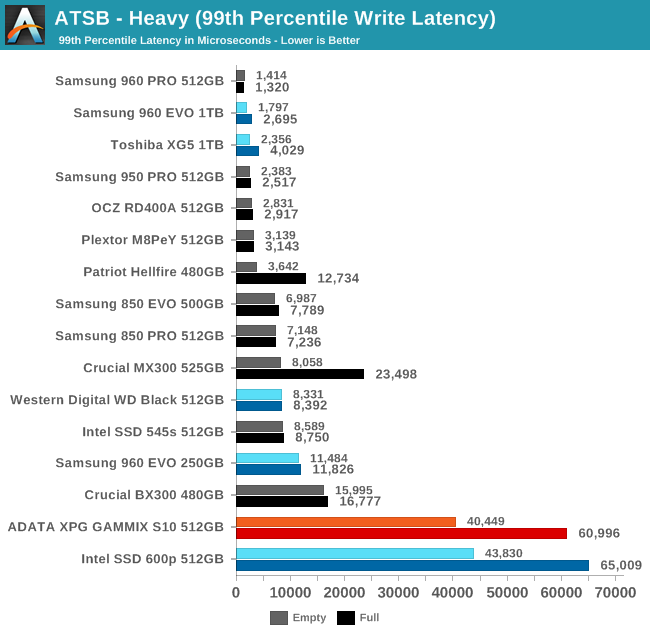
The 99th percentile read latency of the GAMMIX S10 is good, beating some MLC-based NVMe SSDs and any SATA SSD. The 99th percentile write latency is only slightly better than the Intel 600p, and both have a serious problem with controlling write latency.
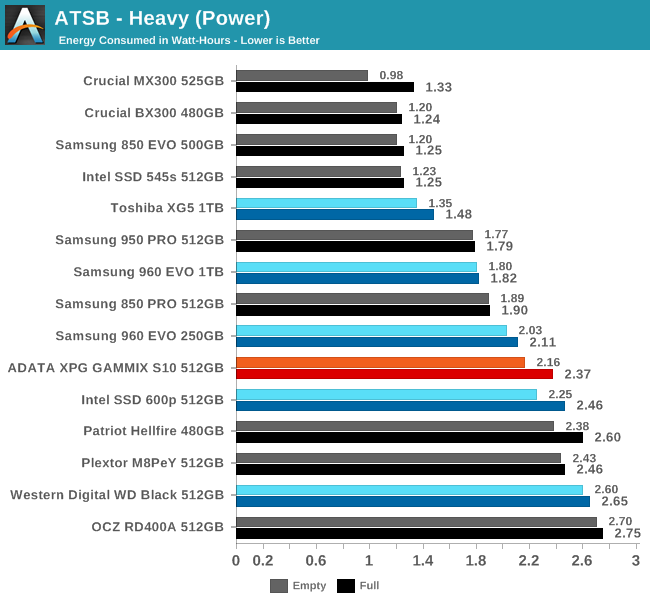
The power consumption of the GAMMIX S10 on the Heavy test is typical for most NVMe SSDs. Good SATA SSDs use much less energy over the course of the test, but few current NVMe SSDs can match the efficiency of SATA, and the GAMMIX S10 isn't one of them.
AnandTech Storage Bench - Light
Our Light storage test has relatively more sequential accesses and lower queue depths than The Destroyer or the Heavy test, and it's by far the shortest test overall. It's based largely on applications that aren't highly dependent on storage performance, so this is a test more of application launch times and file load times. This test can be seen as the sum of all the little delays in daily usage, but with the idle times trimmed to 25ms it takes less than half an hour to run. Details of the Light test can be found here. As with the ATSB Heavy test, this test is run with the drive both freshly erased and empty, and after filling the drive with sequential writes.
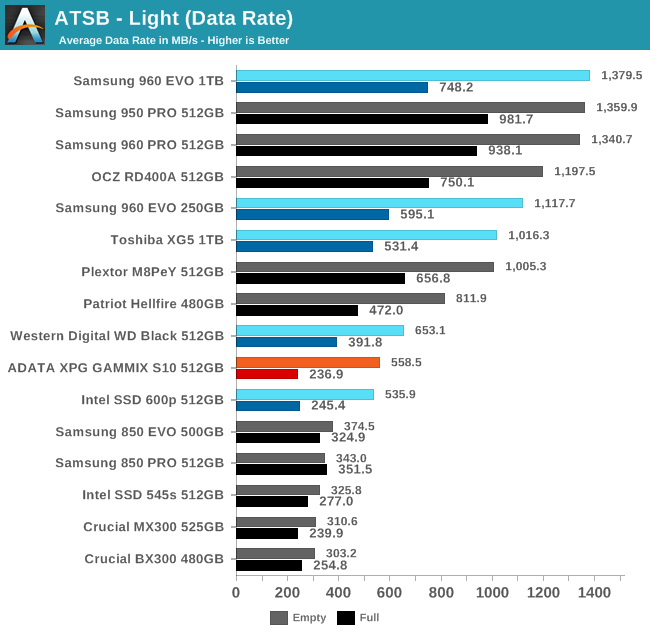
Like the Intel 600p, the ADATA XPG GAMMIX S10 has a substantial performance advantage over all SATA SSDs on the Light test when the test is run on an empty drive. But when the drive is full, the GAMMIX S10 and Intel 600p both suffer more than most drives and fall to an average data rate that is lower than most mainstream SATA drives.
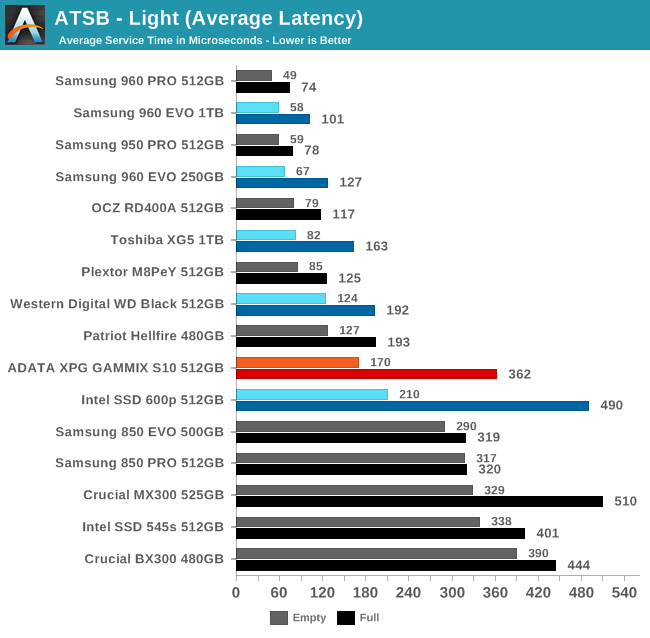
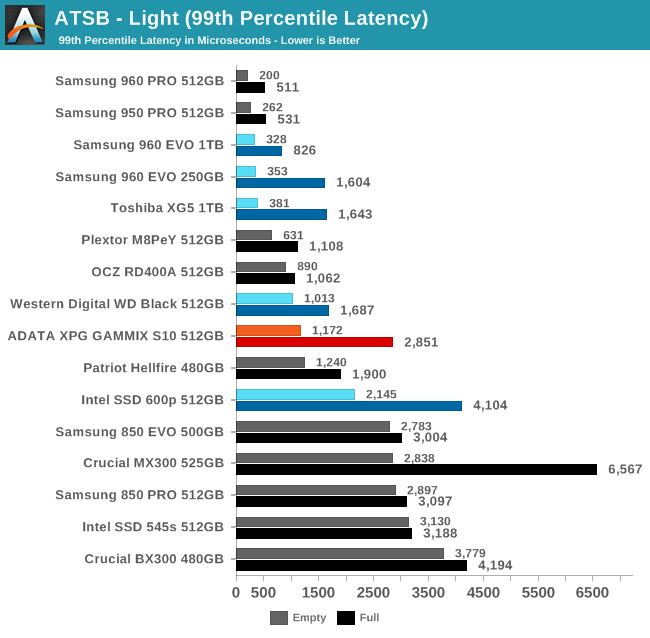
The average and 99th percentile latency scores of the GAMMIX S10 on the Light test are clearly better than the Intel 600p, allowing the GAMMIX S10 to deliver latencies that are no worse than mainstream SATA SSDs even in the worst case of the test running on a full drive. On a freshly erased drive, the GAMMIX S10 offers average latency that is close to other NVMe drives, and the 99th percentile latency is on par with other budget NVMe SSDs.
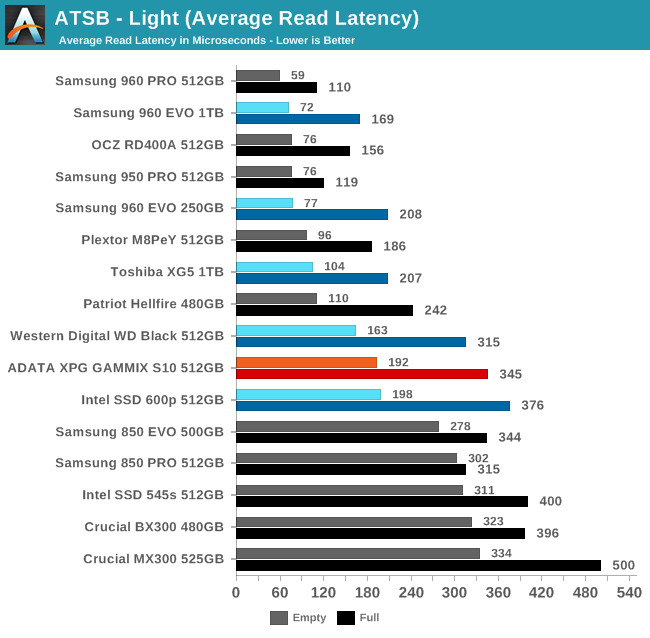
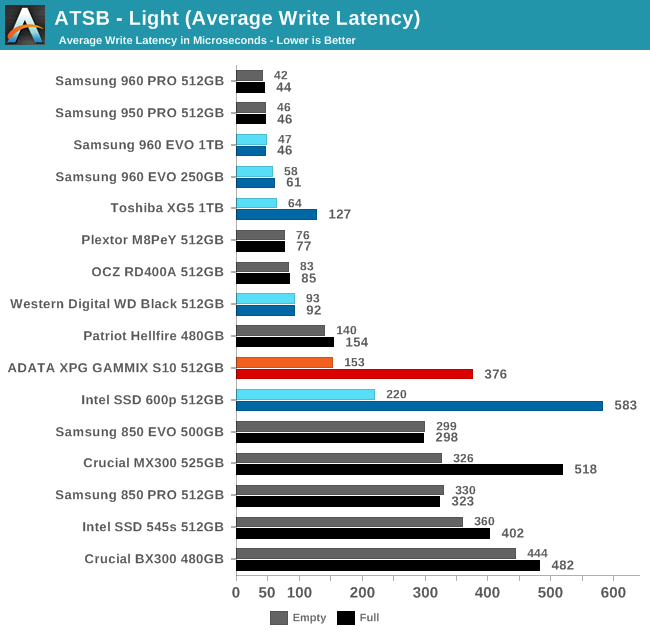
Average read and write latencies for the GAMMIX S10 on the Light test are poor by NVMe standards, but both are better than SATA SSDs when the drive is fresh, and no worse than mainstream SATA when the drive is full.
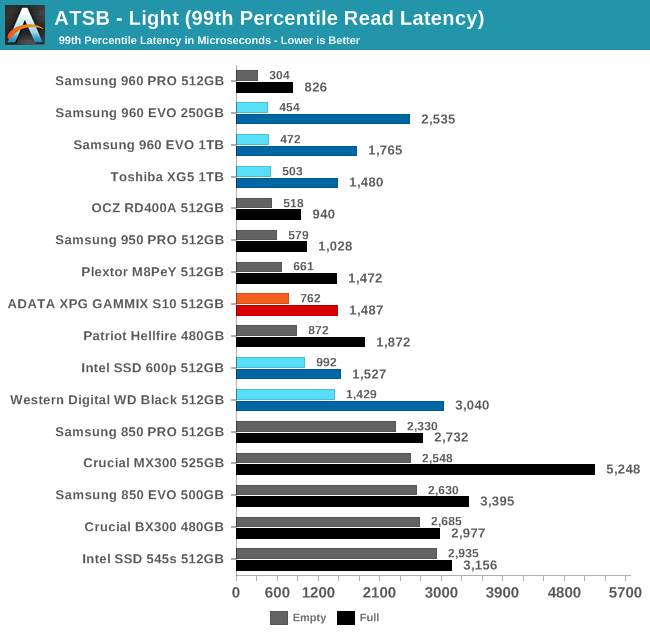
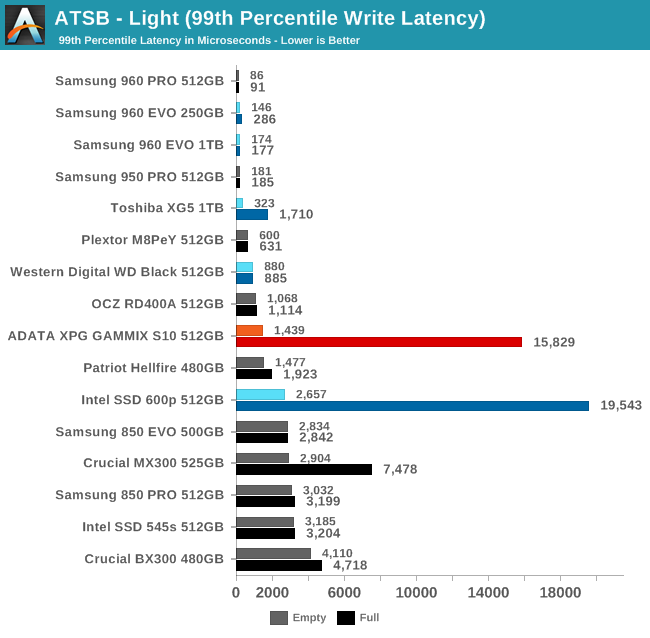
The 99th percentile read latency performance of the GAMMIX S10 is fine for a low-end NVMe drive. On the write side of things the GAMMIX S10 does fine when freshly erased, but the 99th percentile jumps up by a factor of ten when the drive is full. This makes it worse at controlling latency outliers than any mainstream SATA SSD.
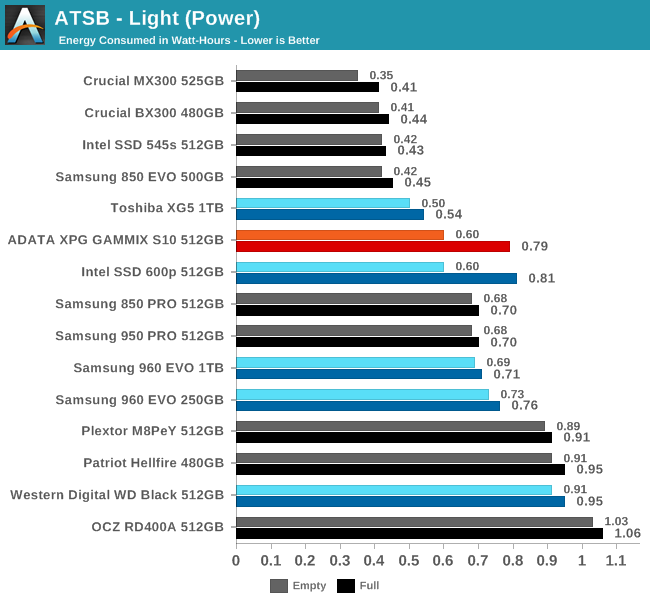
The energy usage of the GAMMIX S10 on the Light test is good compared to most other NVMe SSDs, though the energy usage is much higher when the drive is full. There's still a substantial gap between the energy usage of a typical SATA SSD and that of the GAMMIX S10 or a typical NVMe SSD.
Random Read Performance
Our first test of random read performance uses very short bursts of operations issued one at a time with no queuing. The drives are given enough idle time between bursts to yield an overall duty cycle of 20%, so thermal throttling is impossible. Each burst consists of a total of 32MB of 4kB random reads, from a 16GB span of the disk. The total data read is 1GB.
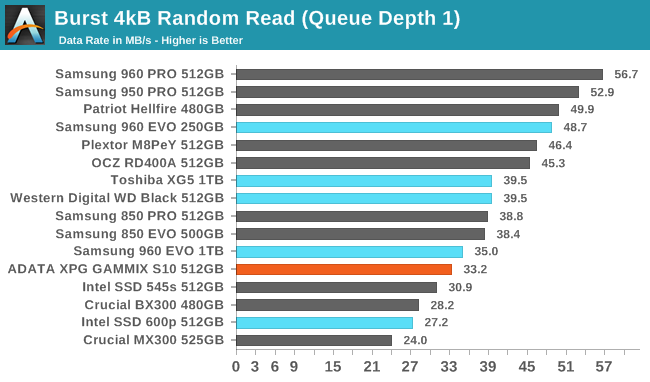
The burst QD1 random read speed of the ADATA XPG GAMMIX S10 is much better than that of the Intel 600p, but still slower than Samsung's SATA SSDs and any other NVMe SSD. The GAMMIX S10 has the highest burst random read speed of any SSD we've tested with Intel/Micron 3D NAND, including the Intel 545s with the second-generation 64L 3D NAND.
Our sustained random read performance is similar to the random read test from our 2015 test suite: queue depths from 1 to 32 are tested, and the average performance and power efficiency across QD1, QD2 and QD4 are reported as the primary scores. Each queue depth is tested for one minute or 32GB of data transferred, whichever is shorter. After each queue depth is tested, the drive is given up to one minute to cool off so that the higher queue depths are unlikely to be affected by accumulated heat build-up. The individual read operations are again 4kB, and cover a 64GB span of the drive.
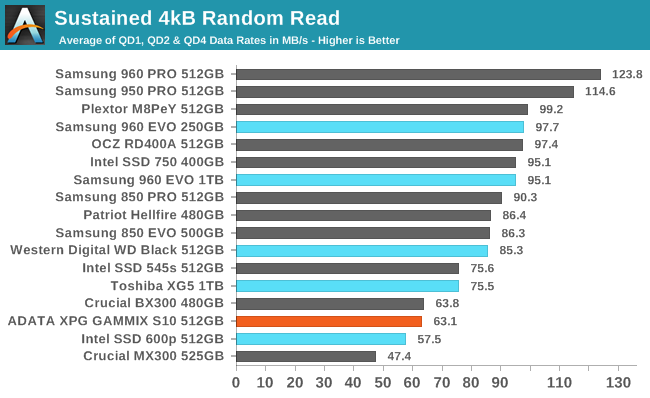
When higher queue depths and longer run times come into play, the random read speed of the GAMMIX S10 doesn't look so good. It is merely tied with the Crucial BX300 and behind the Intel 545s instead of being the fastest Intel/Micron 3D NAND SSD, and everybody else's flash offers faster random read speeds.
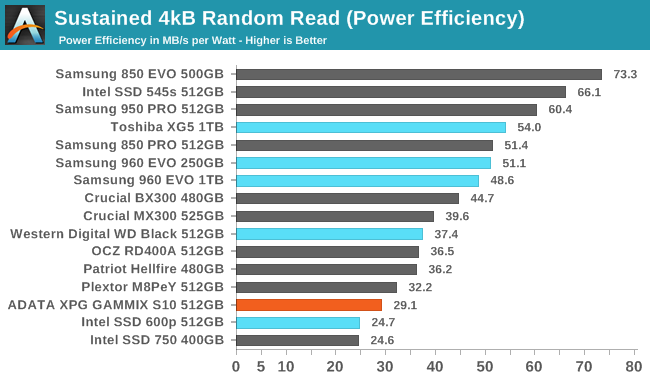
The GAMMIX S10 has poor power efficiency to go along with its poor random read speeds. The best NVMe SSDs using TLC NAND are close to twice as efficient for random reads as the GAMMIX S10.
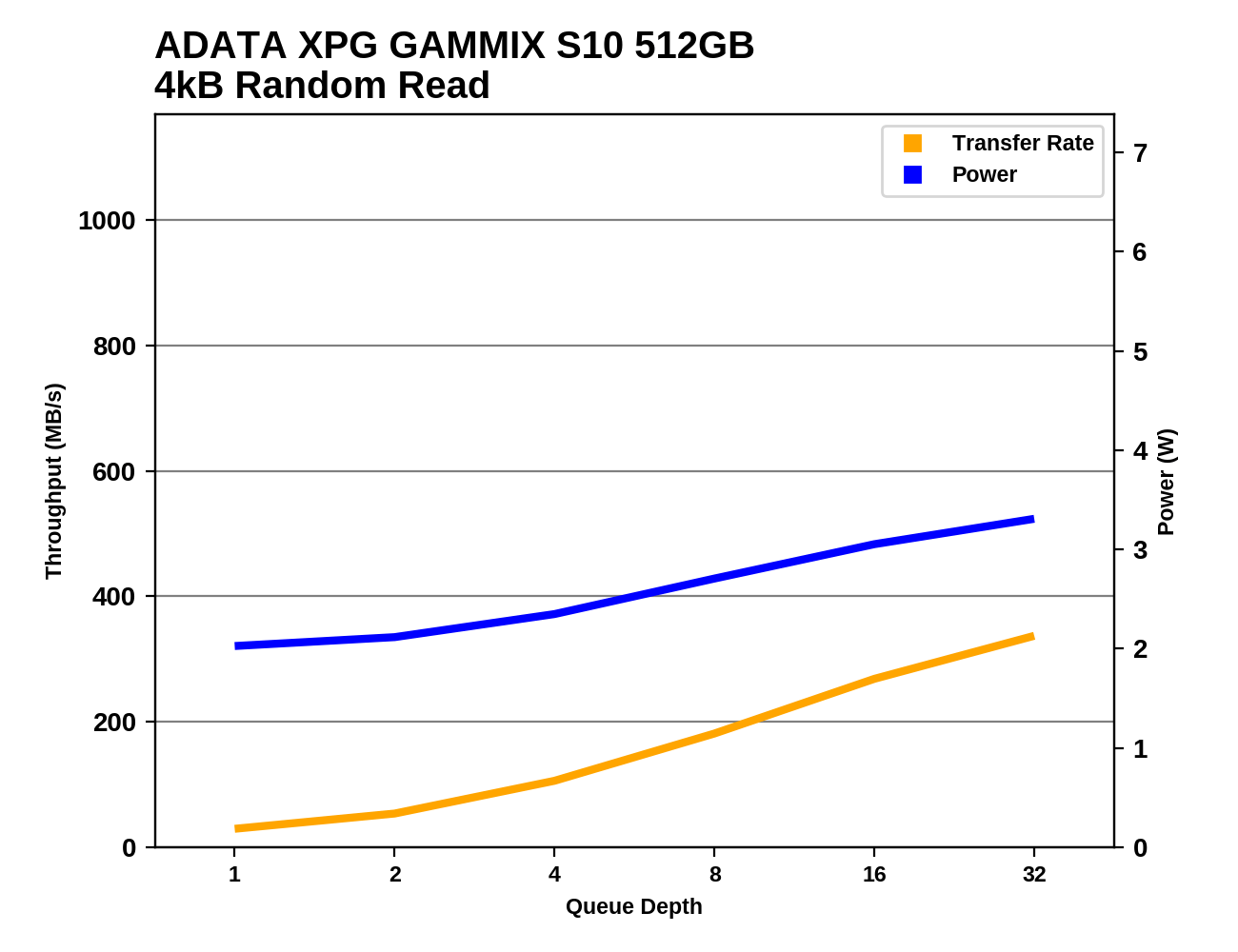 |
|||||||||
The Intel 600p and Crucial MX300 are the only SSDs in this bunch that are slower than the GAMMIX S10 at every queue depth. Any other NVMe SSD scales to much higher random read performance as queue depth increases.
Random Write Performance
Our test of random write burst performance is structured similarly to the random read burst test, but each burst is only 4MB and the total test length is 128MB. The 4kB random write operations are distributed over a 16GB span of the drive, and the operations are issued one at a time with no queuing.
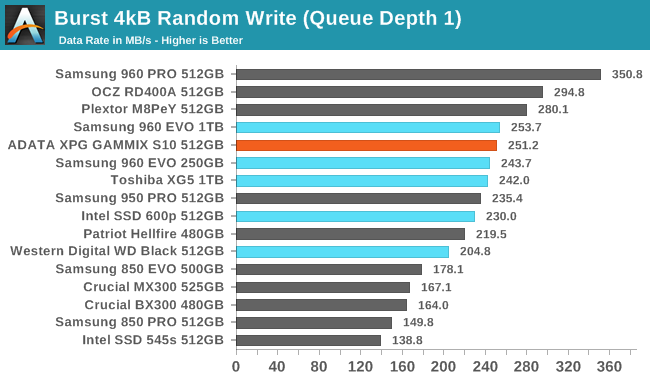
The burst random write speed of the ADATA XPG GAMMIX S10 is pretty good for a TLC-based NVMe SSD. MLC-based NVMe SSDs with more powerful controllers can do even better, but the GAMMIX S10's performance is nothing to complain about.
As with the sustained random read test, our sustained 4kB random write test runs for up to one minute or 32GB per queue depth, covering a 64GB span of the drive and giving the drive up to 1 minute of idle time between queue depths to allow for write caches to be flushed and for the drive to cool down.
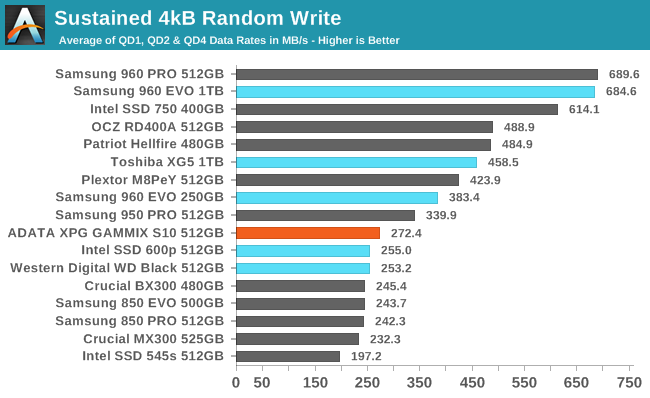
On the longer test of random write performance, the GAMMIX S10 is slightly faster than the Intel 600p and WD Black, which themselves hold a small advantage over SATA SSDs. Most other NVMe SSDs are quite a bit faster than the GAMMIX S10.
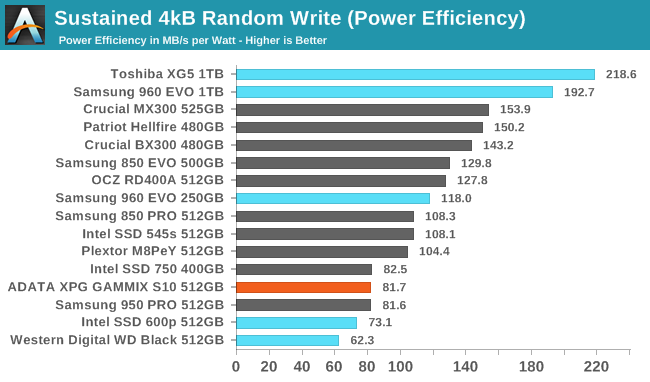
The power efficiency of the GAMMIX S10 during the random write test is not quite as bad as the Intel 600p or WD Black, but it is still poor with performance on par with early NVMe drives like the Samsung 950 PRO and notoriously power-hungry Intel 750.
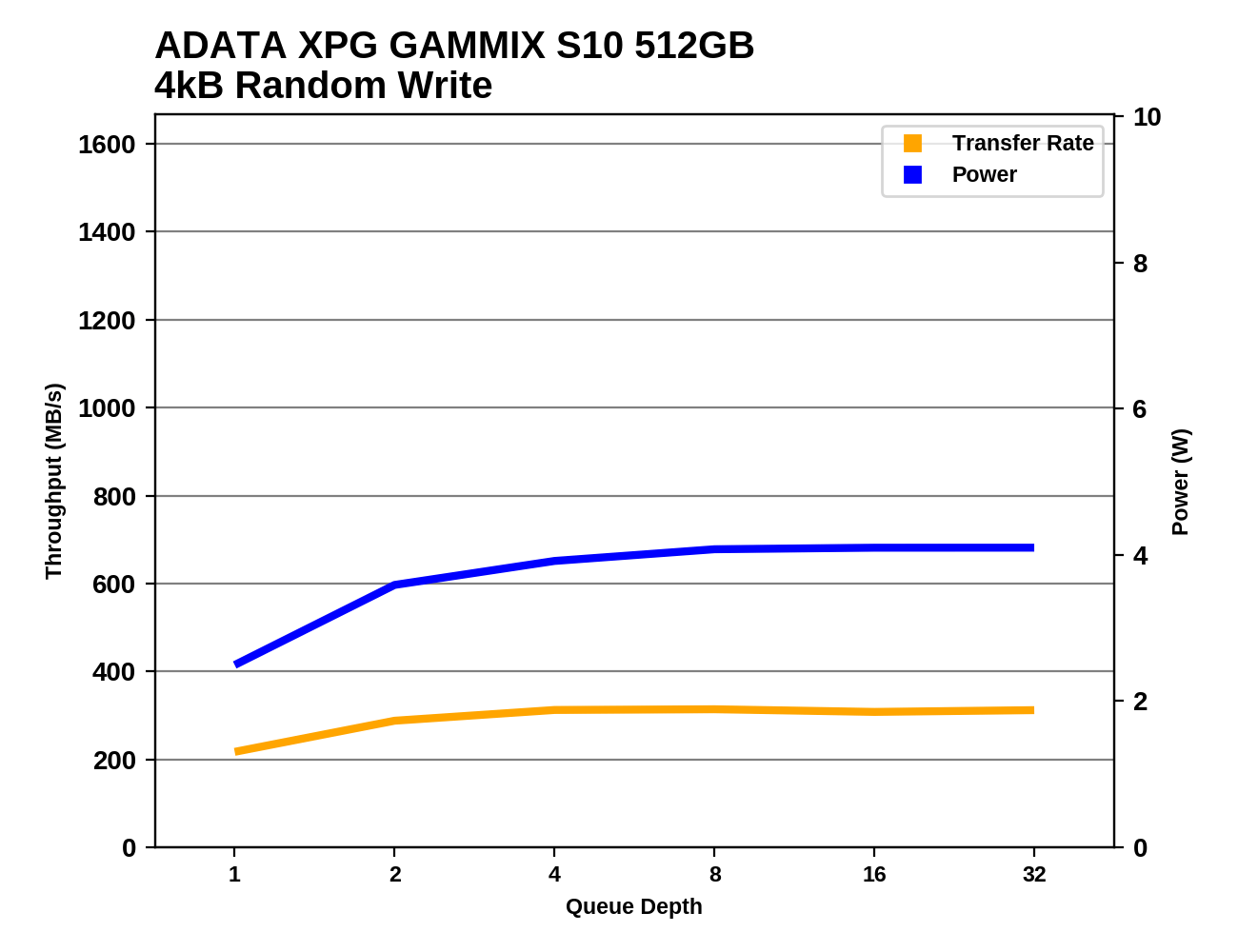 |
|||||||||
The random write speed of the ADATA XPG GAMMIX S10 has mostly saturated by QD2, and the top speed it reaches on this sustained performance test is lower than many mainstream SATA SSDs. Most NVMe SSDs of this capacity or larger are able to continue increasing performance as queue depths grow, leading to performance that surpasses the limits of SATA.
Sequential Read Performance
Our first test of sequential read performance uses short bursts of 128MB, issued as 128kB operations with no queuing. The test averages performance across eight bursts for a total of 1GB of data transferred from a drive containing 16GB of data. Between each burst the drive is given enough idle time to keep the overall duty cycle at 20%.
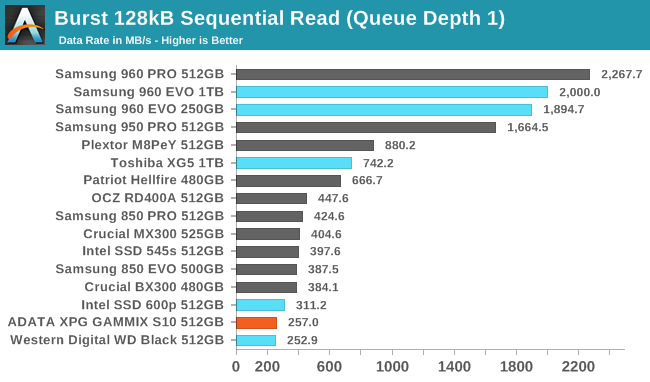
While the ADATA XPG GAMMIX S10 offers good burst random read performance, its burst sequential read performance is very close to last place among this collection of drives. Most mainstream SATA SSDs are quicker on this test, and the Samsung 960 EVO is more than seven times faster.
Our test of sustained sequential reads uses queue depths from 1 to 32, with the performance and power scores computed as the average of QD1, QD2 and QD4. Each queue depth is tested for up to one minute or 32GB transferred, from a drive containing 64GB of data.
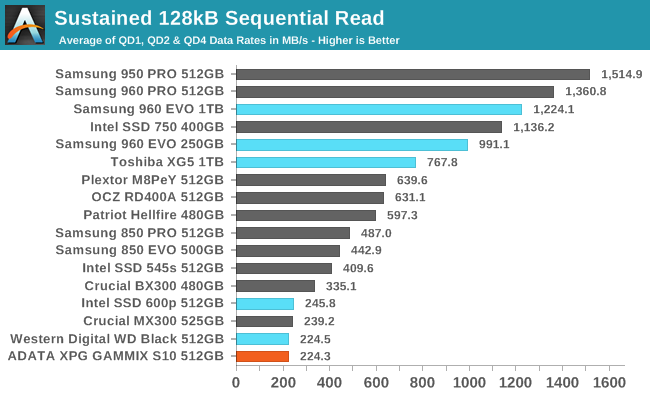
On the longer sequential read test, the GAMMIX S10 comes in last place, tied with the WD Black and just a hair behind the Crucial MX300 and Intel 600p. The PCIe interface isn't helping at all here; Micron's 3D NAND is just too slow.
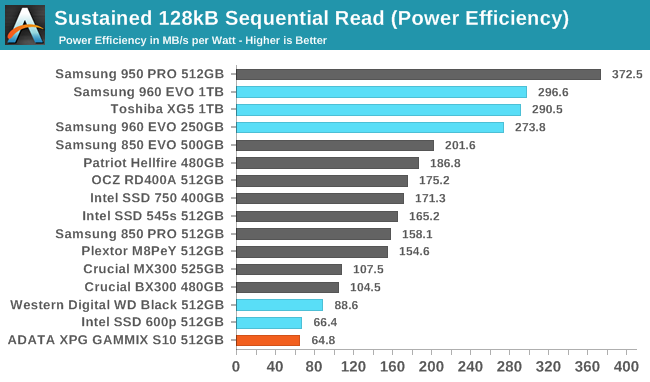
The power efficiency of the GAMMIX S10 is also in last place alongside the Intel 600p, and on this metric the WD Black has a small advantage. The other TLC-based NVMe SSDs deliver more than four times the performance per Watt.
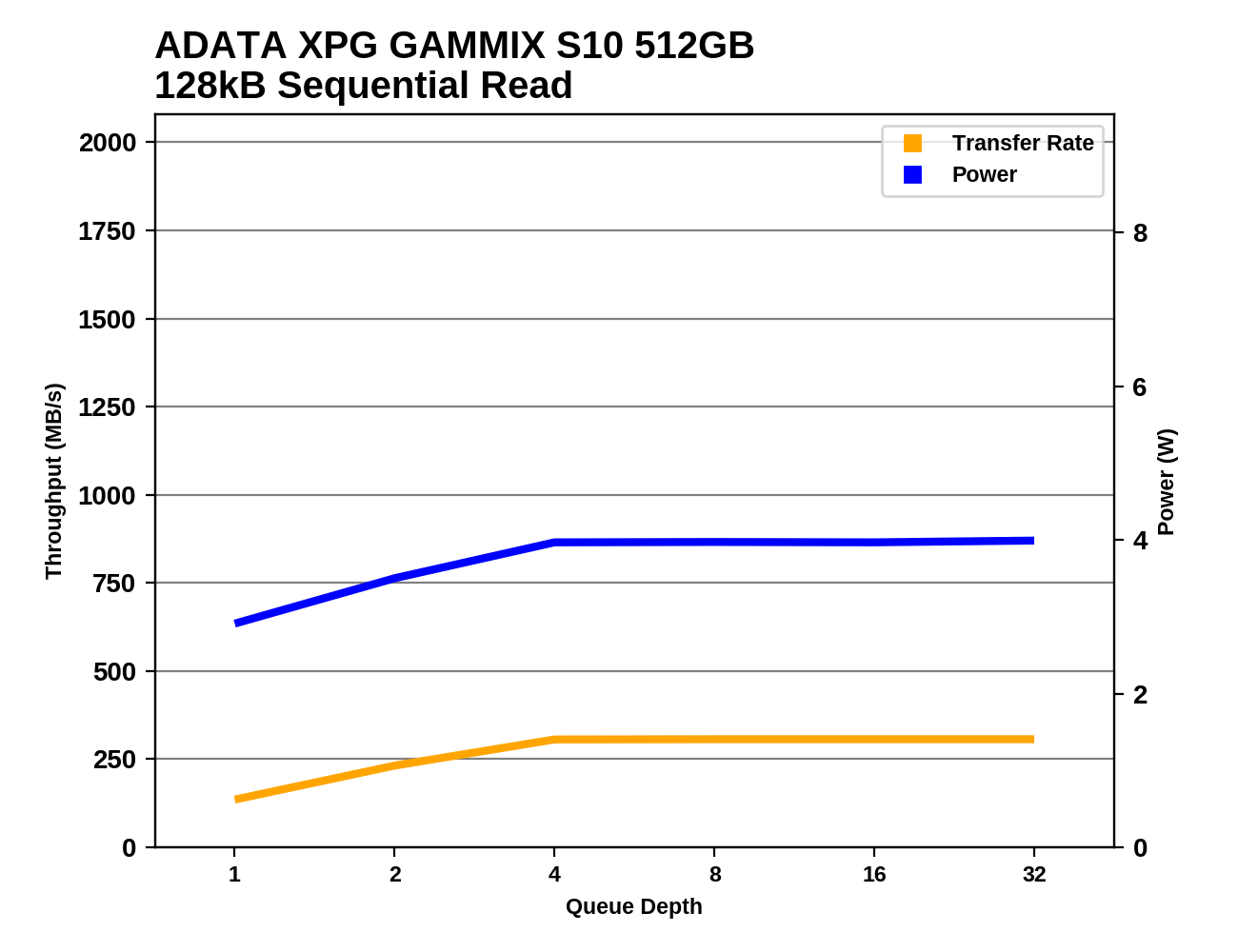 |
|||||||||
The sequential read performance of the GAMMIX S10 doesn't saturate until QD4, and that top speed is unimpressive even by SATA standards. With power consumption only reaching about 4W, thermal throttling is unlikely to be the problem. Instead, this is mostly a limitation of the flash itself, though the controller isn't making the situation better.
Sequential Write Performance
Our test of sequential write burst performance is structured identically to the sequential read burst performance test save for the direction of the data transfer. Each burst writes 128MB as 128kB operations issued at QD1, for a total of 1GB of data written to a drive containing 16GB of data.
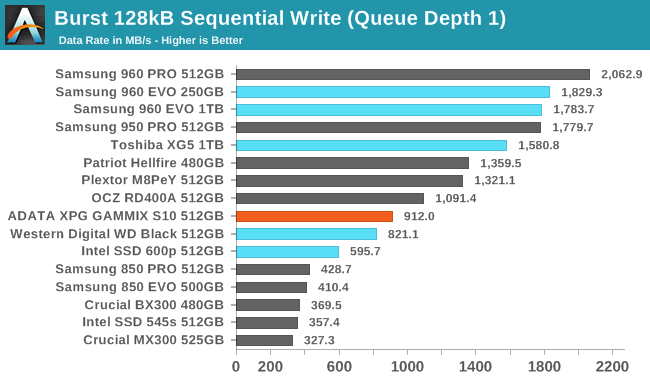
The burst sequential write speed of the ADATA XPG GAMMIX S10 is much higher than the Intel 600p and more than twice as fast as a SATA SSD. The GAMMIX S10 still falls on the low end by NVMe standards.
Our test of sustained sequential writes is structured identically to our sustained sequential read test, save for the direction of the data transfers. Queue depths range from 1 to 32 and each queue depth is tested for up to one minute or 32GB, followed by up to one minute of idle time for the drive to cool off and perform garbage collection. The test is confined to a 64GB span of the drive.
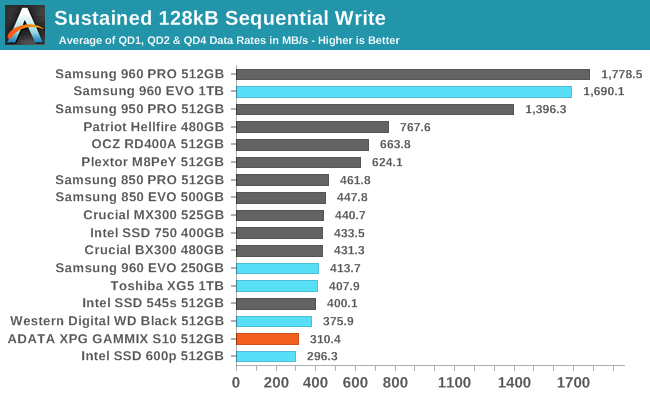
On the longer sequential write test, the GAMMIX S10's performance falls apart. It is barely faster than the last-place Intel 600p, and can't keep up with the typical mainstream SATA SSD.
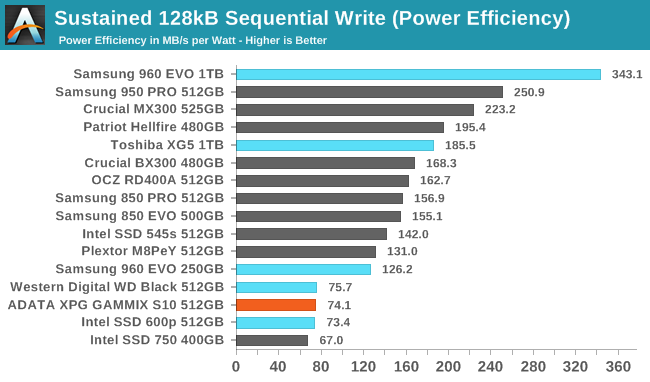
The GAMMIX S10's power efficiency during the sustained sequential write test is bad, but at least it isn't alone at the bottom of the chart: both the Intel 600p and 750 rank slightly below the GAMMIX S10, and the WD Black's efficiency is comparable. Among the rest of the field, there isn't a clear separation between NVMe and SATA SSDs when it comes to efficiency; the fast NVMe drives pay for that performance with higher power consumption.
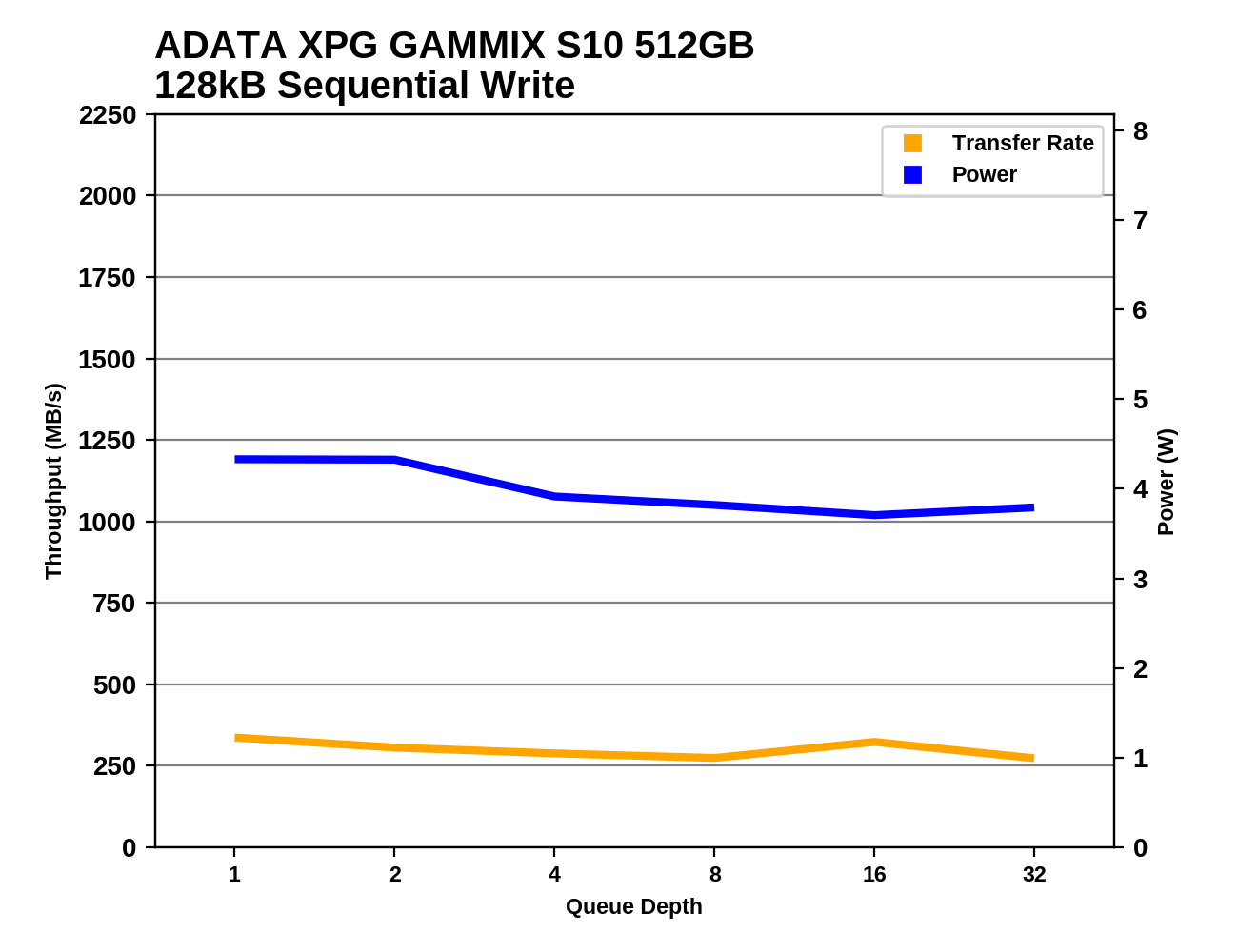 |
|||||||||
The sequential write performance of the ADATA XPG GAMMIX S10 doesn't increase with higher queue depths, and instead the performance drops and varies a bit as the SLC cache is filled and background garbage collection adds some overhead.
Mixed Random Performance
Our test of mixed random reads and writes covers mixes varying from pure reads to pure writes at 10% increments. Each mix is tested for up to 1 minute or 32GB of data transferred. The test is conducted with a queue depth of 4, and is limited to a 64GB span of the drive. In between each mix, the drive is given idle time of up to one minute so that the overall duty cycle is 50%.
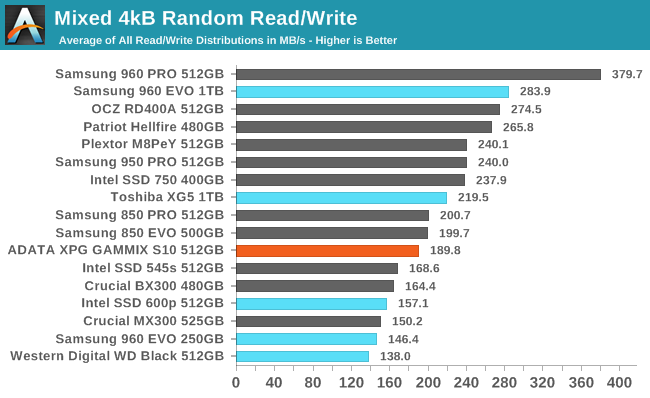
The ADATA XPG GAMMIX S10 doesn't quite outperform every SATA SSD on the mixed random I/O test, but it comes close. The performance is respectable for a TLC-based SSD and is a substantial improvement over the Intel 600p.
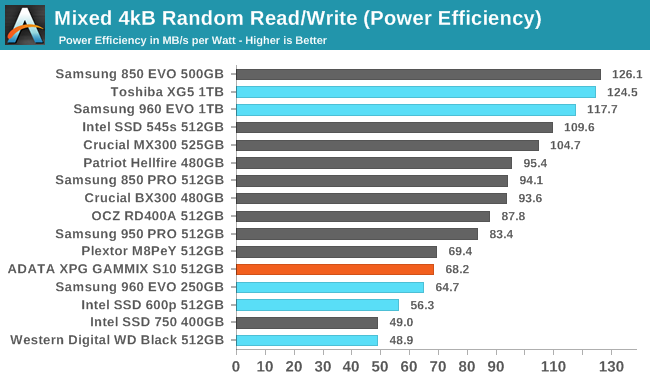
The power efficiency of the GAMMIX S10 beats most of the TLC-based NVMe SSDs, but that is the least efficient product segment in general.
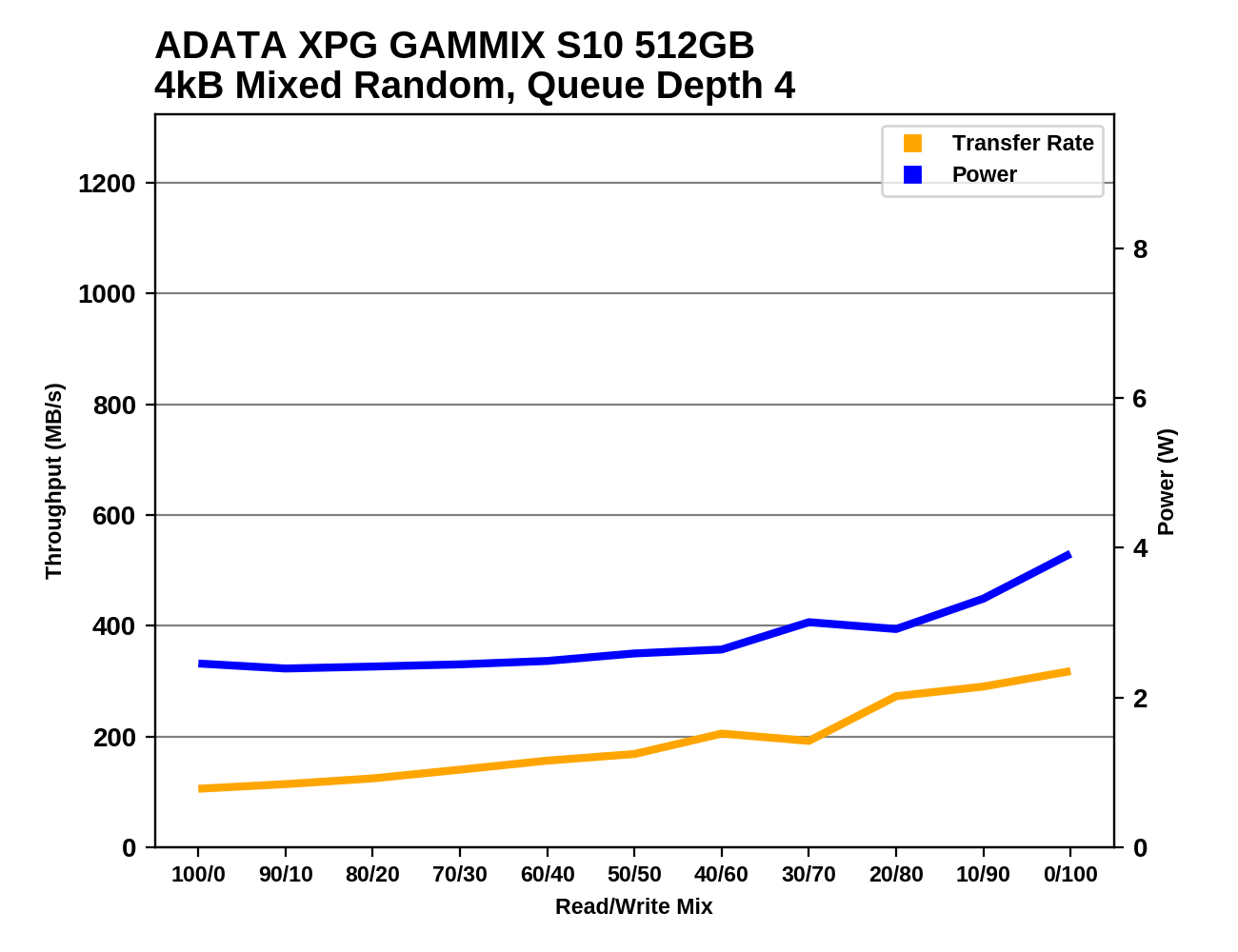 |
|||||||||
The performance of the ADATA XPG GAMMIX S10 generally increases as the portion of writes in the random I/O workload grows, but the SLC cache does fill up and cause some trouble. The GAMMIX S10 is also unable to use its caching to deliver a much higher level of performance in the final phase of the test when the workload consists purely of random writes.
Mixed Sequential Performance
Our test of mixed sequential reads and writes differs from the mixed random I/O test by performing 128kB sequential accesses rather than 4kB accesses at random locations, and the sequential test is conducted at queue depth 1. The range of mixes tested is the same, and the timing and limits on data transfers are also the same as above.
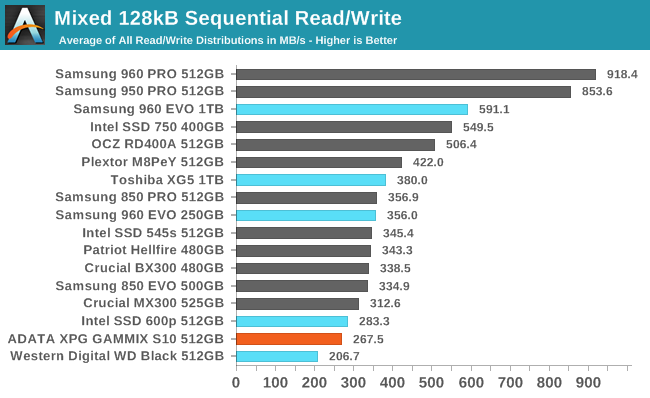
The ADATA XPG GAMMIX S10 was near last place on both the sequential read and write tests, so it is no surprise to see it once again near the bottom of the chart on this mixed sequential I/O test. On average, a typical mainstream SATA SSD will offer better sequential I/O performance.
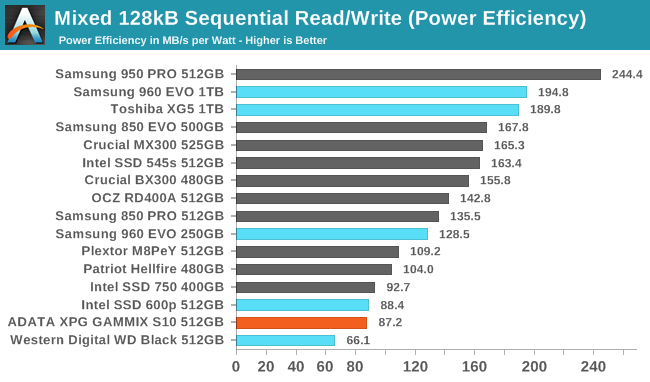
As with performance, the power efficiency of the GAMMIX S10 on the mixed sequential write test is second worst. The WD Black is significantly slower and less efficient, while the gap between the GAMMIX S10 and the Intel 600p is quite small.
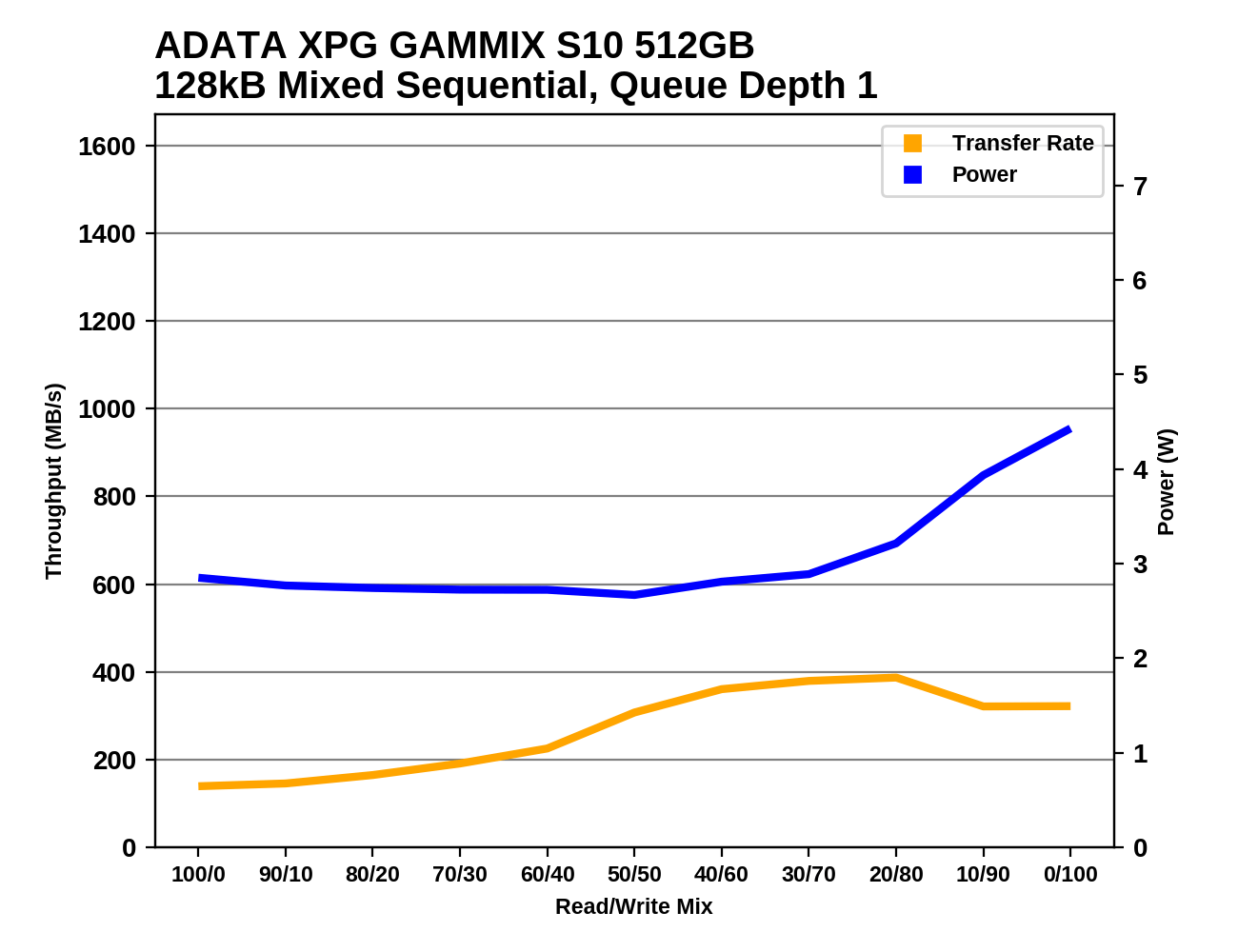 |
|||||||||
As with the random mixed I/O test, the mixed sequential I/O test fills the caches of the GAMMIX S10, leading to lower and less consistent performance toward the end of the test, after a first half showing modest performance increases.
Power Management
Real-world client storage workloads leave SSDs idle most of the time, so the active power measurements presented earlier in this review only account for a small part of what determines a drive's suitability for battery-powered use. Especially under light use, the power efficiency of a SSD is determined mostly be how well it can save power when idle.
SATA SSDs are tested with SATA link power management disabled to measure their active idle power draw, and with it enabled for the deeper idle power consumption score and the idle wake-up latency test. Our testbed, like any ordinary desktop system, cannot trigger the deepest DevSleep idle state.
Idle power management for NVMe SSDs is far more complicated than for SATA SSDs. NVMe SSDs can support several different idle power states, and through the Autonomous Power State Transition (APST) feature the operating system can set a drive's policy for when to drop down to a lower power state. There is typically a tradeoff in that lower-power states take longer to enter and wake up from, so the choice about what power states to use may differ for desktop and notebooks.
We report two idle power measurements. Active idle is representative of a typical desktop, where none of the advanced PCIe link or NVMe power saving features are enabled and the drive is immediately ready to process new commands. The idle power consumption metric is measured with PCIe Active State Power Management L1.2 state enabled and NVMe APST enabled.
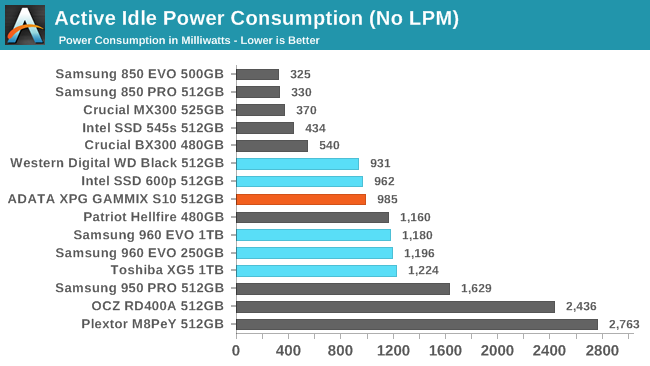
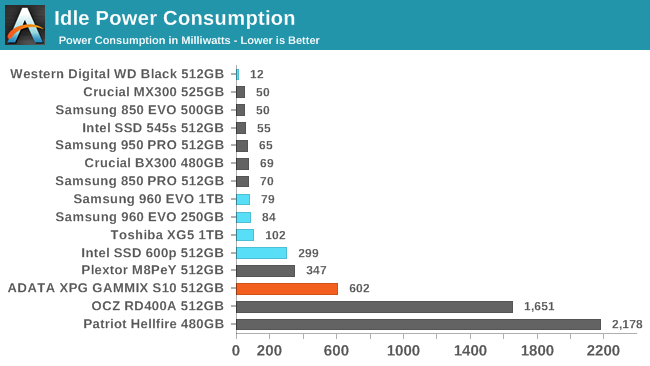
The power management of the ADATA XPG GAMMIX S10 is a step backward from the Intel 600p. The two have similar active idle power consumption, but when enabling deeper sleep states the GAMMIX S10 ends up drawing twice as much power as the Intel 600p and an order of magnitude more than good SATA SSDs.
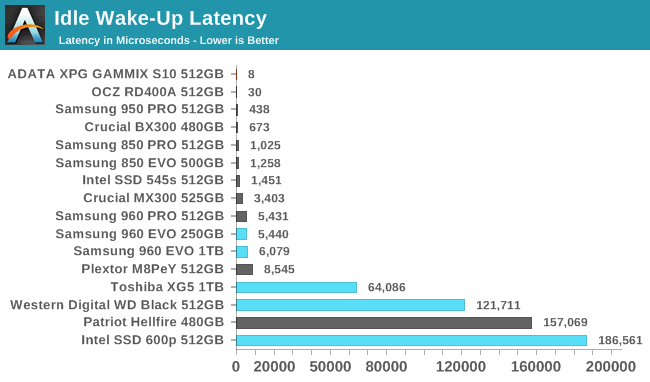
The poor idle power management of the GAMMIX S10 is offset by a near-instant wake-up time. The Intel 600p is one of several NVMe SSDs with a remarkably long wake-up time from their sleep states, while the GAMMIX S10's shallower suspend state clearly allows for a quick return to normal operation.
Conclusion
M.2 PCIe SSDs are usually regarded as high-end SSDs, and the GAMMIX S10 plays into this with the styled heatspreader. But underneath, it's an entry-level NVMe SSD that does not reliably outperform SATA SSDs. The ADATA XPG GAMMIX S10 behaves quite similarly to the Intel SSD 600p, albeit a little bit faster on most tests. They share the same basic strengths and weaknesses. The ADATA XPG SX7000, which is the same as the GAMMIX S10 but without the heatspreader, also falls into this category. All three use the same SM2260 controller and Intel/Micron 3D TLC.
In good conditions like a light workload with plenty of idle time and plenty of spare capacity, the GAMMIX S10 will perform substantially faster than any SATA SSD. But when subjected to intense workloads or when operating nearly full, the GAMMIX S10 gets dramatically slower. Users with storage-intense workloads who need to go beyond the limits of SATA should look to other drives. Users with the kind of lightweight workloads that the GAMMIX S10 can handle well will rarely experience storage being a significant bottleneck, even with a mainstream SATA SSD. That leaves this whole category of entry-level NVMe SSDs viable only when they're competing against SATA SSDs on price, and that isn't happening much in today's market. Good affordable SATA SSDs like the Samsung 850 EVO and Crucial BX300 are much cheaper than the ADATA XPG GAMMIX S10, SX7000 or the Intel 600p.
| 128GB | 250GB | 500-512GB | 1TB | |
| ADATA XPG GAMMIX S10 | $77.99 (61¢/GB) | $119.99 (47¢/GB) | $279.99 (55¢/GB) | |
| ADATA XPG SX7000 | $129.99 (51¢/GB) | $187.99 (37¢/GB) | ||
| ADATA XPG SX8000 | $89.49 (70¢/GB) | $117.57 (46¢/GB) | $227.97 (45¢/GB) | $499.99 (49¢/GB) |
| Samsung 960 EVO | $117.60 (47¢/GB) | $254.98 (51¢/GB) | $435.59 (44¢/GB) | |
| Samsung 960 PRO | $289.99 (57¢/GB) | $586.99 (58¢/GB) | ||
| Plextor M8Pe | $99.99 (78¢/GB) | $144.98 (57¢/GB) | $269.00 (53¢/GB) | $446.00 (44¢/GB) |
| Plextor M8Se | $81.00 (63¢/GB) | $126.00 (49¢/GB) | $240.00 (47¢/GB) | $448.00 (44¢/GB) |
| MyDigitalSSD BPX | $69.99 (58¢/GB) | $124.99 (50¢/GB) | $219.99 (46¢/GB) | |
| Toshiba OCZ RD400 | $116.01 (91¢/GB) | $136.62 (53¢/GB) | $239.99 (47¢/GB) | $584.68 (57¢/GB) |
| Intel SSD 600p | $94.99 (74¢/GB) | $129.99 (51¢/GB) | $199.99 (39¢/GB) | $299.99 (29¢/GB) |
The pricing on ADATA's NVMe drives is a bit inconsistent, with the MLC-based SX8000 undercutting the TLC-based GAMMIX S10 in some capacities. Some of this is probably due to different models having been released more recently than others (with the SX8000 being one of their earlier releases this year), but the main factor is probably the NAND shortage leading to different SKUs being out of stock or nearly so at different retailers. However, we can assess the general pricing trends and where the GAMMIX S10 and SX7000 seem to fall within them.
The current sale on the 512GB SX7000 for $187.99 is a great deal for a NVMe SSD; prices under 40¢/GB are fairly uncommon. At the 1TB capacity, ADATA's SX7000 and GAMMIX S10 are hard to find, and the Intel 600p can currently be had for $299.99. Barring exceptional deals like these, the general pattern is that Samsung's 960 EVO is usually aggressively priced and almost always the best performer for its price. For smaller capacities (256GB and below), MLC-based drives should be preferred because they tend to be less reliant on SLC caching to improve performance, and they tend to suffer less when nearly full. The MyDigitalSSD BPX is one of the cheapest drives using the combination of the Phison E7 controller and Toshiba planar MLC, and at the 128GB capacity it is currently cheaper than the GAMMIX S10.
Next year, we could see a very different situation in this product segment. Silicon Motion's second generation of NVMe controllers promises big performance increases, and includes low-cost models that will allow entry-level NVMe drives to be priced even closer to SATA SSDs while offering much better performance. The 64-layer Intel/Micron 3D TLC NAND flash memory can solve the rest of the performance problems with drives like the GAMMIX S10. Consequently, the next round of entry-level NVMe drives pairing up Silicon Motion controllers with Intel/Micron 3D NAND should be far more appealing products. But they'll also face increased competition as Phison's second-generation NVMe controllers hit the market and get paired with Toshiba 3D NAND that can also deliver much better performance and power consumption than the GAMMIX S10 or Intel 600p.

